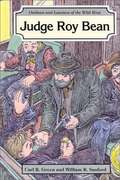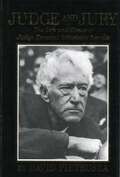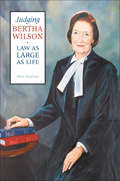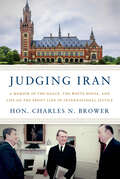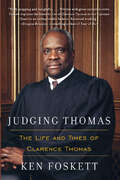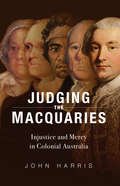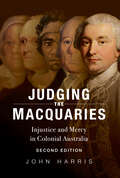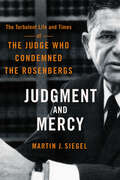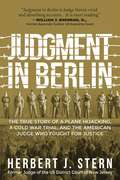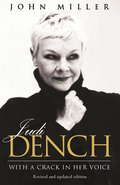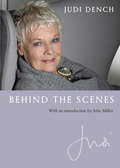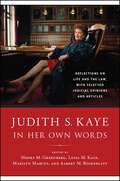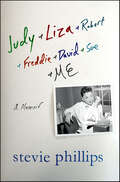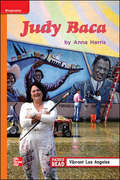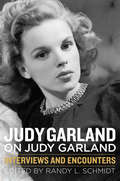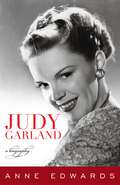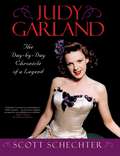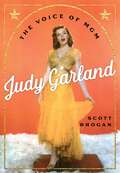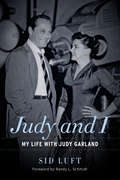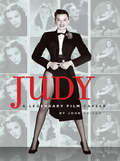- Table View
- List View
Judge Roy Bean (Outlaws and Lawmen of the Wild West)
by Carl R. Green William R. Sanford- Biographies of famous and infamous men of the Western frontier. - Entices the reluctant reader to relive the exciting days of the Wild West.
Judge and Jury: The Life and Times of Judge Kenesaw Mountain Landis
by David PietruszaJudge Kenesaw Mountain Landis is most famous for his role as the first Commissioner ever to rule organized baseball. But before he came into his legendary position as baseball's final say, Landis already had built a reputation from his Chicago courtroom as the most popular and most controversial federal judge in World War I-era America. Judge and Jury is the first complete biography of the Squire, from the origins of his unusual name through his career as a federal judge and his clean-up after the infamous Black Sox scandal.
Judging Bertha Wilson
by Ellen AndersonMadame Justice Bertha Wilson, the first woman appointed to the Supreme Court of Canada, is an enormously influential and controversial figure in Canadian legal and political history. This engaging, authorized, intellectual biography draws on interviews conducted under the auspices of the Osgoode Society for Legal History, held in Scotland and Canada with Madame Justice Wilson, as well as with her friends, relatives, and colleagues. The biography traces Wilson's story from her birth in Scotland in 1923 to the present. Wilson's contributions to the areas of human rights law and equality jurisprudence are many and well-known. Lesser known are her early days in Scotland and her work as a minister's wife or her post-judicial work on gender equality for the Canadian Bar Association and her contributions to the Royal Commission on Aboriginal Peoples.Through a scrupulous survey of Wilson's judgements, memos, and academic writings (many as yet unpublished), Ellen Anderson shows how Wilson's life and the law were seamlessly integrated in her persistent commitment to a stance of principled contextuality. This stance has had an enduring effect on the evolution of Canadian law and cultural history. Supported with the warmth and generosity of Wilson's numerous personal anecdotes, this work illuminates the life and throught of a woman who has left an extraordinary mark on Canada's legal landscape.
Judging Bush
by Robert Maranto Tom Lansford Jeremy JohnsonThere is no shortage of opinions on the legacy that George W. Bush will leave as 43rd President of the United States. Recognizing that Bush the Younger has been variously described as dimwitted, opportunistic, innovative, and bold, it would be presumptuous to draw any hard and fast conclusions about how history will view him. Nevertheless, it is well within academia's ability to begin to make preliminary judgments by weighing the evidence we do have and testing assumptions. In the wake of the September 11 terrorist attacks and the initially successful military campaign in Afghanistan, Bush and his administration enjoyed nearly unprecedented popularity. But after failures in Iraq and in the federal government's response to Hurricane Katrina, Bush's approval ratings plummeted. Guided by a new framework,Judging Bushboldly takes steps to evaluate the highs and lows of the Bush legacy according to four types of competence: strategic, political, tactical, and moral. It offers a first look at the man, his domestic and foreign policies, and the executive office's relationship to the legislative and judicial branches from a distinguished and ideologically diverse set of award-winning political scientists and White House veterans. Topics include Bush's decision-making style, the management of the executive branch, the role and influence of Dick Cheney, elections and party realignment, the Bush economy, Hurricane Katrina, No Child Left Behind, and competing treatments of the wars in Iraq and Afghanistan. Contributors include Lara M. Brown, David B. Cohen, Jeffrey E. Cohen, Laura Conley, Jack Covarrubias, John J. DiIulio, Jr. , William A. Galston, Frederick M. Hess, Karen M. Hult, Lori A. Johnson, Robert G. Kaufman, Anne M. Khademian, Lawrence J. Korb, Patrick McGuinn, Michael Moreland, Costas Panagopoulos, James P. Pfiffner, Richard E. Redding, Neil Reedy, Andrew Rudalevige, Charles E. Walcott, and Shirley Anne Warshaw.
Judging Iran: A Memoir of The Hague, The White House, and Life on the Front Line of International Justice
by Hon. Charles N. BrowerFrom a divided Berlin to The Hague, the Reagan White House, the forests of Costa Rica, and more, Judge Charles N. Brower shares a personal history of a life spent at the forefront of international justice— and a case for the role of law in preserving global peace.A judge of the Iran– United States Claims Tribunal for four decades, Charles N. Brower is aninternationally recognized leader in arbitration and has handled cases on six continents. With quick wit and a keen eye for adventure, he takes readers on a tour of his extraordinary career.As a young lawyer fresh from Harvard, Brower quickly made partner at a Wall Streetfirm. After just four months, however, he left the expected path to join the U.S. State Department, embarking on a career that put him in the thick of Cold War Europe and led to a lifelong focus on international law.Brower' s drive carried him to the heart of pressing issues, including globalization, governmental ethics, environmentalism, and human rights. At each stop, Brower encountered criminals and victims, advocates and miscreants, especially at the Iran– United States Claims Tribunal, where heated disagreements between judges once erupted into physical violence. His work at The Hague was interrupted only by his time as an advisor to President Ronald Reagan at the height of the Iran– Contra scandal, and Brower eventually became the most-appointed American judge ad hoc of the International Court of Justice.Judging Iran is a frank insider account of the highest echelons of international law. As an active judge to this day, Brower offers a nuanced history of modern arbitration between nations, from our earliest concept of international law to today' s efforts for justice. And, as a global citizen, he argues that the law is essential in our work for peace.
Judging Thomas: The Life and Times of Clarence Thomas
by Ken FoskettClarence Thomas, the youngest and most controversial member of the Supreme Court, could become the longest-serving justice in history, influencing American law for decades to come. Who is this enigmatic man? And what does he believe in?Judging Thomas tells the remarkable story of Clarence Thomas's improbable journey from hardscrabble beginnings in the segregated South to the loftiest court in the land. With objectivity and balance, author Ken Foskett chronicles Thomas's contempt for upper-crust blacks who snubbed his uneducated, working-class roots; his flirtation with the priesthood and, later, Black Power; the resentment that fueled his opposition to affirmative action; the conservative beliefs that ultimately led him to the Supreme Court steps; and the inner resilience that propelled him through the doors.Based on interviews with Thomas himself, fellow justices, family members, and hundreds of friends and associates, Judging Thomas skillfully unravels perhaps the most complex, controversial, and powerful public figure in America today.
Judging the Macquaries: Injustice and Mercy in Colonial Australia
by John HarrisThe Black Lives Matter movement is bringing the characters of powerful people in colonial times into sharp focus, particularly their attitudes and actions towards slavery and indigenous peoples. Lachlan and Elizabeth Macquarie are among those being scrutinised and reassessed. They arrived at the penal colony of NSW, a remote outpost of the British empire in 1809. The European invaders had barely survived two decades in an alien environment but, for countless millennia, home to its Aboriginal inhabitants. Lachlan was the new governor. Elizabeth, his wife, was his closest friend and fiercest supporter.The colony was an unruly mix of convicts, soldiers and settlers. At the time, Lachlan Macquarie’s leadership was judged by his handling of the convicts. Lachlan and Elizabeth treated the convicts humanely, forgiving them and restoring them to society. His superiors considered him far too lenient, yet to Sydneysiders, as ‘The Father of Australia’, he had gifted them the path to a prosperous future.Today, Lachlan is being judged by his treatment of Aboriginal people. The Macquaries thought they were being kind, yet they ignored the injustice of dispossession. Aboriginal people were British citizens under the protection of British law – a law they were expected to obey. Although known for his humanity, Lachlan had a fatal flaw. When hostilities broke out between Aborigines and settlers on the outskirts of the colony, he took the fateful decision to send in the military. This will never be forgotten, yet his sins were the sins of the empire he tried so hard to serve.Award-winning author and historian John Harris never baulks at handling controversial subjects. In this timely book, he tackles the disputes that marked Lachlan Macquarie’s period as governor and the complex controversies which still surround his actions today.
Judging the Macquaries: Injustice and Mercy in Colonial Australia
by John HarrisThe Black Lives Matter movement is bringing the characters of powerful people in colonial times into sharp focus, particularly their attitudes and actions towards slavery and indigenous peoples. Lachlan and Elizabeth Macquarie are among those being scrutinised and reassessed. They arrived at the penal colony of NSW, a remote outpost of the British empire in 1809. The European invaders had barely survived two decades in an alien environment but, for countless millennia, home to its Aboriginal inhabitants. Lachlan was the new governor. Elizabeth, his wife, was his closest friend and fiercest supporter.The colony was an unruly mix of convicts, soldiers and settlers. At the time, Lachlan Macquarie’s leadership was judged by his handling of the convicts. Lachlan and Elizabeth treated the convicts humanely, forgiving them and restoring them to society. His superiors considered him far too lenient, yet to Sydneysiders, as ‘The Father of Australia’, he had gifted them the path to a prosperous future.Today, Lachlan is being judged by his treatment of Aboriginal people. The Macquaries thought they were being kind, yet they ignored the injustice of dispossession. Aboriginal people were British citizens under the protection of British law – a law they were expected to obey. Although known for his humanity, Lachlan had a fatal flaw. When hostilities broke out between Aborigines and settlers on the outskirts of the colony, he took the fateful decision to send in the military. This will never be forgotten, yet his sins were the sins of the empire he tried so hard to serve.Award-winning author and historian John Harris never baulks at handling controversial subjects. In this timely book, he tackles the disputes that marked Lachlan Macquarie’s period as governor and the complex controversies which still surround his actions today.
Judgment and Mercy: The Turbulent Life and Times of the Judge Who Condemned the Rosenbergs
by Martin J. SiegelIn Judgment and Mercy, Martin J. Siegel offers an insightful and compelling biography of Irving Robert Kaufman, the judge infamous for condemning Julius and Ethel Rosenberg to death for atomic espionage.In 1951, world attention fixed on Kaufman's courtroom as its ambitious young occupant stridently blamed the Rosenbergs for the Korean War. To many, the harsh sentences and their preening author left an enduring stain on American justice. But then the judge from Cold War central casting became something unexpected: one of the most illustrious progressive jurists of his day. Upending the simplistic portrait of Judge Kaufman as a McCarthyite villain, Siegel shows how his pathbreaking decisions desegregated a Northern school for the first time, liberalized the insanity defense, reformed Attica-era prisons, spared John Lennon from politically motivated deportation, expanded free speech, brought foreign torturers to justice, and more. Still, the Rosenberg controversy lingered. Decades later, changing times and revelations of judicial misconduct put Kaufman back under siege. Picketers dogged his footsteps as critics demanded impeachment. And tragedy stalked his family, attributed in part to the long ordeal. Instead of propelling him to the Supreme Court, as Kaufman once hoped, the case haunted him to the end.Absorbingly told, Judgment and Mercy brings to life a complex man by turns tyrannical and warm, paranoid and altruistic, while revealing intramural Jewish battles over assimilation, class, and patriotism. Siegel, who served as Kaufman's last law clerk, traces the evolution of American law and politics in the twentieth century and shows how a judge unable to summon mercy for the Rosenbergs nonetheless helped expand freedom for all.
Judgment in Berlin: The True Story of a Plane Hijacking, a Cold War Trial, and the American Judge Who Fought for Justice
by Herbert J. Stern"Suspenseful...moving...equal to any fictional thriller." —San Francisco Chronicle In August 1978, the Iron Curtain still hung heavily across Europe. To escape from oppressive East Berlin, an East German couple, Hans Detlef Alexander Tiede and Ingrid Ruske, hijacked a Polish airliner and diverted it to the American sector of West Berlin. Along with the couple, several passengers spontaneously defected to the West, and were welcomed by US officials. But within hours, Communist officials reminded the West of the anti-hijacking agreements in the Warsaw Pact, and thus the fugitives were arrested by the US State Department. Thirty-four years after World War II, the United States built a court in the middle of West Berlin, the former capital of the Third Reich, in the building that once housed the Luftwaffe, to try the hijacking couple. Former NJ district attorney, now a judge, Herbert J. Stern was appointed the "United States Judge for Berlin." What followed was a trial full of maneuvers and strategies that would put Perry Mason to shame, and answered the question: what is allowed to people seeking freedom? Judgment in Berlin, also a major motion picture starring Martin Sheen and Sean Penn, is unsurpassed as a true-life suspense story, with its vivid accounts of daring escapes, close calls, diplomatic intrigue, and dramatic courtroom confrontations. The original edition won the Freedom Foundation Award, and this updated edition includes a new introduction from author and trial judge Herbert J. Stern.
Judi Dench: With A Crack In Her Voice
by John MillerThe first full biography of Britain's leading actress of her time.Whether it is her sunny temperament, her gift of laughter, her wide-ranging abilities, or all three, Judi Dench is without doubt a star. Shortlisted for a 1998 Oscar for her performance as Queen Victoria in MRS BROWN, she then won one for her role as Queen Elizabeth in SHAKESPEARE IN LOVE. Judi Dench is widely loved, and not only among the theatrical profession. Her long-running appearance opposite Geoffrey Palmer in the TV situation comedy AS TIME GOES BY has run to four series and gained her a TV TIMES readers' award as ¿the actress we most wish see more often on television¿. She juggles the National Theatre (a sell-out season in Sondheim's A LITTLE NIGHT MUSIC and David Hare's AMY'S VIEW) with TV and films (she is now established as 'M' in the latest James Bond series).Since the paperback edition was published, John Miller has written a new chapter, bringing what is fast becoming a classic biography completely up-to-date.
Judi Dench: With A Crack In Her Voice
by John MillerThe first full biography of Britain's leading actress of her time.Whether it is her sunny temperament, her gift of laughter, her wide-ranging abilities, or all three, Judi Dench is without doubt a star. Shortlisted for a 1998 Oscar for her performance as Queen Victoria in MRS BROWN, she then won one for her role as Queen Elizabeth in SHAKESPEARE IN LOVE. Judi Dench is widely loved, and not only among the theatrical profession. Her long-running appearance opposite Geoffrey Palmer in the TV situation comedy AS TIME GOES BY has run to four series and gained her a TV TIMES readers' award as ¿the actress we most wish see more often on television¿. She juggles the National Theatre (a sell-out season in Sondheim's A LITTLE NIGHT MUSIC and David Hare's AMY'S VIEW) with TV and films (she is now established as 'M' in the latest James Bond series).Since the paperback edition was published, John Miller has written a new chapter, bringing what is fast becoming a classic biography completely up-to-date.
Judi: With an Introduction by John Miller
by Dame Judi Dench'National treasure? I hate that. Too dusty, too in a cupboard, too behind glass, too staid ... What I love is being part of a company. On stage I am not trying to be myself, I'm trying to be someone else, the more unlike me the better.'From her first theatrical roles as a teenager in York to her scene-stealing performances as 'M' in the James Bond films, Dame Judi Dench's professional life has consisted of non-stop acting, leading to numerous accolades, including an Academy Award.BEHIND THE SCENES is a uniquely personal take on Dame Judi's life and brilliant career, showing her off stage as well as on: in the wings, off sets, in dressing rooms and happily larking about. Beautifully illustrated with photographs from her own collections, here are reflections and reminiscences on those who have mattered to her most - her family, fellow actors, directors and writers - communicated with the truth and insight of her acting.
Judi: With an Introduction by John Miller
by Judi Dench'National treasure? I hate that. Too dusty, too in a cupboard, too behind glass, too staid ... What I love is being part of a company. On stage I am not trying to be myself, I'm trying to be someone else, the more unlike me the better.'From her first theatrical roles as a teenager in York to her scene-stealing performances as 'M' in the James Bond films, Dame Judi Dench's professional life has consisted of non-stop acting, leading to numerous accolades, including an Academy Award.BEHIND THE SCENES is a uniquely personal take on Dame Judi's life and brilliant career, showing her off stage as well as on: in the wings, off sets, in dressing rooms and happily larking about. Beautifully illustrated with photographs from her own collections, here are reflections and reminiscences on those who have mattered to her most - her family, fellow actors, directors and writers - communicated with the truth and insight of her acting.
Judith S. Kaye in Her Own Words: Reflections on Life and the Law, with Selected Judicial Opinions and Articles (Excelsior Editions)
by Judith S. KayeIn 1983, Judith S. Kaye (1938–2016) became the first woman appointed to the Court of Appeals, New York's highest court. Ten years later, she became the first woman to be appointed chief judge of the xourt, and by the time she retired, in 2008, she was the longest-serving chief judge in the court's history. During her long career, she distinguished herself as a lawyer, jurist, reformer, mentor, and colleague, as well as a wife and mother. Bringing together Kaye's own autobiography, completed shortly before her death, as well as selected judicial opinions, articles, and speeches, Judith S. Kaye in Her Own Words makes clear why she left such an enduring mark upon the court, the nation, and all who knew her.The first section of the book, Kaye's memoir, focuses primarily on her years on the Court of Appeals, the inner workings of the court, and the challenges she faced, as chief judge, in managing a court system populated by hundreds of judges and thousands of employees.The second section, a carefully chosen selection of her written opinions (and occasional dissents), reveals how she guided the law in New York State for almost a quarter century with uncommon vision and humanity. Her decisions cover every facet of New York and federal law and have often been quoted and followed nationally.The final section of the book includes selections from her numerous articles and speeches, which cover the field, from common law jurisprudence to commercial law to constitutional analysis, all with an eye to the future and, above all, how the law can best affect the everyday lives of people who come to court—willingly or unwillingly—including, not least, those most in need of the law."An extraordinary woman, jurist, and leader who had a striking impact on the law and the administration of justice in New York State and beyond. This collection is more than a simple record of a remarkable life. It is a treasure—not only for those of us who knew and admired Judith but for all who may seek to understand and appreciate the profound impact she had on the law, the legal profession, and the administration of justice." — from the Foreword by Honorable Janet DiFiore
Judy + Liza + Robert + Freddie + David + Sue + Me: A Memoir
by Stevie PhillipsNo star burned more ferociously than Judy Garland. And nobody witnessed Garland's fierce talent at closer range than Stevie Phillips. During the Mad Men era, Stevie Philips was a young woman muscling her way into the manscape of Manhattan's glittering office towers. After a stint as a secretary, she began working for Freddie Fields and David Begelman at Music Corporation of America (MCA) under the glare of legendary über-agent Lew Wasserman. When MCA blew apart, Fields and Begelman created Creative Management Associates (CMA), and Stevie went along. Fields convinced Garland to come on board, and Stevie became, as she puts it, "Garland's shadow," putting out fires-figurative and literal-in order to get her to the next concert in the next down-and-out town. Philips paints a portrait of Garland at the bitter end and although it was at times a nightmare, Philips says, "She became my teacher," showing her "how to" and "how not to" live.Stevie also represented Garland's fiercely talented daughter, Liza Minnelli, as well as Robert Redford, Paul Newman, Henry Fonda, George Roy Hill, Bob Fosse, Cat Stevens, and David Bowie. She produced both films and Broadway shows and counted her colleague, the legendary agent Sue Mengers, among her closest confidantes. Now Stevie Phillips reveals all in Judy & Liza & Robert & Freddie & David & Sue & Me..., a tough-talking memoir by a woman who worked with some of the biggest names in show business. It's a helluva ride.
Judy Blume's Story
by Betsy LeeA biography of Judy Blume, perhaps the most popular writer of juvenile fiction today, based on first hand information from the writer herself.
Judy Garland on Judy Garland: Interviews and Encounters
by Randy L. SchmidtJudy Garland on Judy Garland is the closest we will come to experiencing and exploring the legend's planned autobiography. Collecting and presenting the most important Garland interviews and encounters that took place between 1935 and 1969, this work opens with her first radio appearance under contract with Metro-Goldwyn-Mayer, and concludes with her last known interview, one taped for Radio Denmark just months before her death. What makes this collection unique is that it places Judy in the role of storyteller. She wrote a number of essays for various publications and sat for countless print, radio, and television interviews. These and other autobiographical efforts she made are proof that Judy Garland wanted her story told in her own words. Finally, 45 years after her death, here it is.
Judy Garland: A Biography
by Anne EdwardsEdwards&’s biography presents a complete picture of the late actress—and not just the boozing, drug-addicted caricature of a woman central to lesser biographies. We learn, for example, that Garland saw it as her duty to provide for her family financially, a generosity that her mother Ethel exploited with disastrous results. Above all, Judy Garland sought to please, whether it was an audience or a studio head, and therein lies her powerful and heartbreaking story.
Judy Garland: The Day-by-Day Chronicle of a Legend
by Scott SchechterThis day-by-day account of the legend's life—the first of its kind—succeeds in the daunting task of tracking Judy's myriad professional pursuits, the personal crises she triumphed over, and her many accomplishments.Lavishly illustrated with eighty rare photos, this volume contains new information to enthrall even the most knowledgeable Garland fan. For those just encountering Judy, this book provides the perfect introduction, an engrossing narrative bursting with information: her performance dates, concert set lists, and recording session schedules; the evolving critical reception to her work; the many celebrities that came into contact with and adored Judy, from the Beatles to Elvis to Sinatra; her filming itineraries and guest appearances; excerpts from rare interviews and press conferences; and much more.Here is Judy Garland as never viewed before, in a way that allows readers to see her whole life on a daily basis and come to their own conclusion about what her life was really about. They will encounter a survivor, parent, friend, and one of the greatest entertainers the world has ever known, who overcame one obstacle after another in order to devote forty-five of her forty-seven years to delighting her fans. From her debut performance as a Gumm Sister at age two to her final day, Judy Garland is the definitive chronicle of this remarkable icon.
Judy Garland: The Voice of MGM
by Scott BroganA Definitive Celebration of Hollywood's Iconic Musical Star and Her Legendary CareerMore than 100 years after her birth, Judy Garland remains the gold standard by which all movie musical leading ladies are judged. She is revered and celebrated by current stars, directors, songwriters, and others in the entertainment industry. She also has a fan base that is as large as that of Marilyn Monroe or James Dean. Her image, especially &“Dorothy&” in The Wizard of Oz (1939), is an instantly recognized icon. Garland really was the voice of MGM during her tenure and after. No documentary about any aspect of the history of the MGM Studios is complete without Garland&’s voice on the soundtrack. When people think of MGM Musicals, they think of Garland along with Gene Kelly and Fred Astaire. She&’s the only female in that exalted &“top three.&” There have been many books about Garland&’s fabled and troubled life, but none devoted solely to the study (and celebration) of her years at MGM. She entered the studio as a 13-year-old contract player in 1935. She left the studio in 1950 carrying the title &“Metro&’s Greatest Asset.&” Judy Garland: The Voice of MGM will focus on Garland&’s films, but it will also delve into her other professional achievements such as her extensive appearances on radio programs, her long association with Decca Records, and her personal appearances, highlighted by her two USO Bond Tours in the early 1940s. This will be the definitive book about Garland&’s legendary career at MGM, pulling back the curtain to reveal the truths about that career while also presenting previously unknown details and facts that are sure to delight her fans as well as fans of classic film.
Judy and I: My Life with Judy Garland
by Randy L. Schmidt Sid LuftThe third of Judy Garland's five husbands, Sid Luft was the one man in her life who stuck around. He was chiefly responsible for the final act of Judy's meteoric comeback after she was unceremoniously booted off the MGM lot: he produced her iconic, Oscar-nominated vehicle A Star Is Born and expertly shaped her concert career. Previously unpublished, Sid Luft's intimate autobiography tells his and Judy's story in hard-boiled yet elegant prose. It begins on a fateful night in New York City when the not quite divorced Judy Garland and the not quite divorced Sid Luft meet at Billy Reed's Little Club and fall for each other. The romance lasted Judy's lifetime, despite the separations, the reconciliations, and the divorce. Under Luft's management, Judy came back bigger than ever, building a singing career that rivaled Sinatra's. However, her drug dependencies and suicidal tendencies put a tremendous strain on the relationship. Sid did not complete his memoir; it ended in 1960 after Judy hired David Begelman and Freddie Fields to manage her career. But Randy L. Schmidt, acclaimed editor of Judy Garland on Judy Garland and author of Little Girl Blue: The Life of Karen Carpenter, seamlessly pieced together the final section of the book from extensive interviews with Sid, most previously unpublished. Despite everything, Sid never stopped loving Judy and never forgave himself for not being able to ultimately save her from the demons that drove her to an early death at age forty-seven in 1969. Sid served as chief conservator of the Garland legacy until his death at the age of eighty-nine in 2005. This is his testament to the love of his life.
Judy: A Legendary Film Career
by John FrickeThrough her incomparable work on screen, stage, record, radio, and television, Judy Garland earned renown as OC The WorldOCOs Greatest Entertainer. OCO It was as a motion pictureastar though, that she first rose to international fame. Fromaher feature film debut in 1936 through the aptly titled "I Could Go on Singing" in 1963, she lit upathe screen with a magic uniquely hersOCoand dazzled world-wide audiences of all ages. aJudy Garlandastarred inatwoadozenaof the all-time classic movie musicals, among them "A Star is Born," "Meet Me in St. Louis," "Babes in Arms"," "" Easter Parade," "For Me and My Gal," and "The Harvey Girls. " Her dramaticaturns in "Judgment at Nuremberg," "The Clock," and "A Child is Waiting" won addedaacclaim. And perhaps most unforgettably, she starred as Dorothy Gale in the best-loved motion picture of all time: "The Wizard of Oz. "a"Judy: A Legendary Film Career"atells the story of GarlandOCOs movie workain unprecedented detail. Hundreds of never-before-published photos, newly-assembled contemporary reviews, insight from her costars and coworkers, and production histories are provided for each film in which she appeared. Highlighting and complimenting the feature films is a definitive biography;aan examinationaofaJudyOCOs short subjects; details of the movies she did not complete; and an enthrallingacompendium of film projects for which she was considered or rumored. The text is illustrated by more than five hundred photos, encompassing poster art; costume tests; behind-the-scenes candids; onstage and backstage glimpses of her theatrical successes; and personal snapshots. a"Judy"ais the exhaustively researched work of historian John Fricke. Heacelebrates as never before the heart, humor, and incandescent motion picture achievement of the one-and-only Judy Garland. "
Judy: The Life, Legend, and Tragedy of an American Icon
by Gerold FrankThe tumultuous life story of Judy Garland, based on more than two hundred interviews and authorized access to her private papers, by the New York Times–bestselling biographer. Gerold Frank met with legendary singer and actress Judy Garland to collaborate on her autobiography—but he completed the project alone after her fatal overdose in 1969. Drawn from more than two hundred interviews and full access to her personal records and pictures, Frank delves into the superstar&’s troubled life, assisted by the cooperation of her family, her doctors, and her friends in Hollywood. Still vivid in our memory thanks to films like The Wizard of Oz, Meet Me in St. Louis, and A Star Is Born, Judy Garland was an incomparable figure whose outsized talent made her an American icon—and her life story, an American tragedy. &“[A] messy and insatiably involving story. . . . Somehow beyond all the mythology of how a star was born and a cult created, Judy&’s consuming presence remains—the insecure charm, the mischievous humor, the guts—all programmed on self-destruct.&” —Kirkus Reviews &“When [Frank] digs into the roots of her behavior, he makes more sense than anybody else I have read. He is the perfect Dante for this trip into the underworld, the biographer Judy Garland deserves.&” —The New York TimesIncludes photographs
